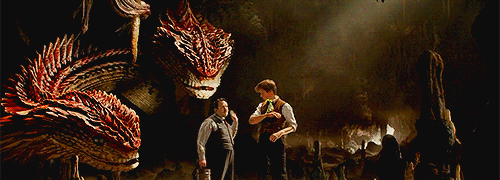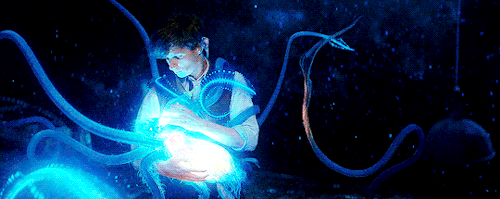To Defeat Grindelwald, Our Heroes Must Learn How to Kill a Hydra
We have two and a half years to wait until the next Fantastic Beasts movie comes out. What do we do in the meantime? Analyze and theorize, of course!
One of my Potterhead friends has already given me something very interesting to theorize about: the apparent Hydra motif throughout Fantastic Beasts: The Crimes of Grindelwald.
A motif is a concept or idea that repeats itself throughout a work and contributes to building a central theme of the work. Objects, dialogue, and imagery can all contribute to building a motif. The Hydra is a many-headed beast from Greek mythology that was famous for being very difficult to kill. When Hercules cut off one of the Hydra’s heads, two more heads grew in the severed head’s place. My friend spotted a few moments throughout Crimes of Grindelwald that build a Hydra motif, which reinforces the central theme of the movie and reveals the key to Grindelwald’s defeat.
While chasing her through the streets of Paris, Newt tells Tina about the Runespoor, a three-headed snake that resembles the Hydra.
At the French Ministry of Magic, Newt, Tina, and Leta encounter matagots when they sneak into the records room. When attacked, a matagot will multiply like the Hydra and become more ferocious.
When Grindelwald sets fire to the Père Lachaise cemetery, the flames erupt in a Hydra-like formation. As described in the screenplay, “The black fire pursues them like a many-headed hydra, erupting out of every mausoleum” (Scene 115).
Some of the details of the plot also evoke the Hydra. For example, Dumbledore warns Travers that his “policies of suppression and violence” against Grindelwald’s followers are “pushing supporters into his arms” and making his movement stronger. Grindelwald’s plan to lure everyone to the Père Lachaise cemetery is a many-headed beast of sorts, carried out by his many-headed inner circle of henchpeople. We get a glimpse into Dumbledore’s own many-headed network of influential figures and into the Ministry’s efforts to cut off those heads in order to prevent Dumbledore from plotting against the government.
Grindelwald’s major victories at the end of the movie also evoke the Hydra. When an Auror reflexively kills the red-haired witch at Grindelwald’s rally, her death is used to spread the message that “it is not we who are violent,” convincing more people to join Grindelwald’s cause in her place. And in a devastating finale, when Grindelwald’s henchman Krall is burned for his disloyalty, two people cross the flames to join Grindelwald’s inner circle in his place: Queenie and Credence.
The central theme that the Hydra motif reinforces is that using violence against Grindelwald only makes him and his movement stronger. That is because the premise of his movement is that wizards live under a violent system that he alone can fix, a system that “demands that [wizards] conceal [their] true nature” and “directs those under its dominion to cower in fear lest [wizards] risk discovery.” The government prohibits people from living and loving freely and even authorizes the use of violence against innocents to keep them in line. Grindelwald’s movement is the Hydra, and trying to fight it by cutting off heads here and there will only make it stronger.
When Hercules fought the Hydra, he soon realized that in order to defeat it, he had to burn the stumps of each head as he cut them off. Attacking the root from which each head grew back was the only way to truly kill the Hydra. Crimes of Grindelwald showed us that the same is true for defeating Grindelwald’s movement. Arresting and killing Grindelwald’s followers will only make his argument stronger. Eradicating Grindelwald will mean defeating both the man and the ideology of wizarding supremacy that is the foundation of his movement.
The Hydra motif illuminates the role that Newt and his friends have to play in the story. It is Dumbledore’s responsibility to fight Grindelwald. But Newt, Tina, Theseus, Jacob, and Nagini will fight against Grindelwald’s vision for the future. Jacob and Nagini represent the vulnerable groups who would be most harmed in Grindelwald’s future. Jacob knows that Queenie is wrong and that Grindelwald is not the answer. Nagini knows that Grindelwald’s pure-blood followers “kill the likes of us for sport.” Newt has built a whole career out of protecting vulnerable beings from violence and teaching people to respect them and treat them with kindness.
Tina and Theseus have seen how the government fails to protect those who need the most protection, and they are working to do better. Tina goes out of her way to protect Credence from his mother, though it gets her fired, and then tries to protect him from both the government and Grindelwald. Theseus tells his Aurors, “We mustn’t be what [Grindelwald] says we are.” Newt and his friends know that a future in which wizards learn to value Muggles, Underbeings, and magical creatures as equal beings worthy of protection and respect is a far better future for everyone than anything Grindelwald is proposing. That means anyone interested in truly vanquishing Grindelwald must continue to work to change wizarding society long after Grindelwald himself is gone.










